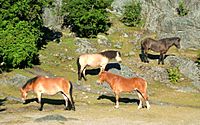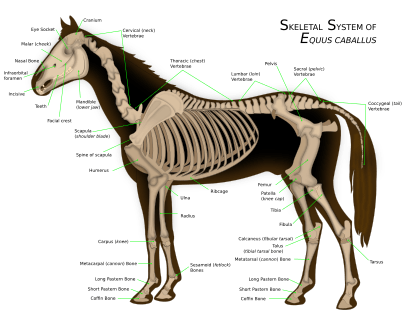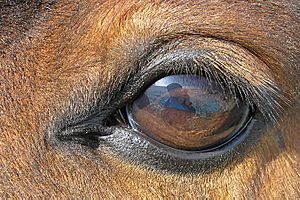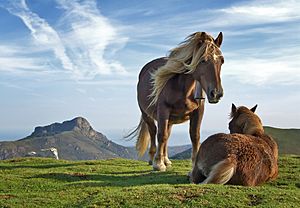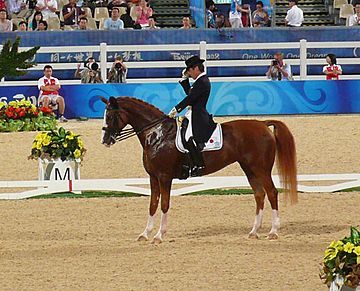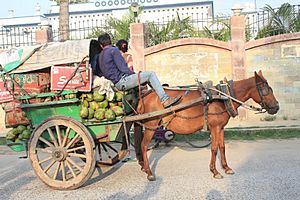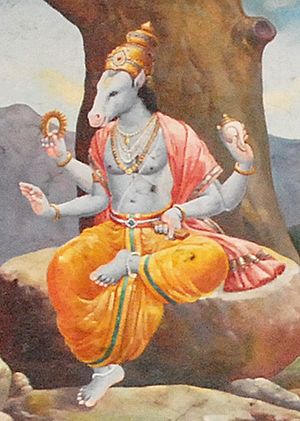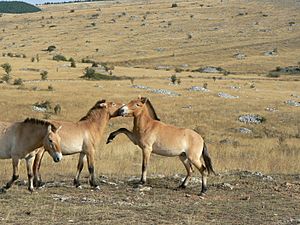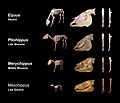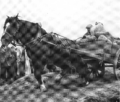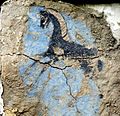Horse facts for kids
Quick facts for kids Horse |
|
|---|---|
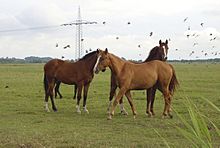 |
|
| Scientific classification | |
| Kingdom: | |
| Class: | |
| Order: | |
| Family: | |
| Genus: | |
| Binomial name | |
| Equus caballus Linnaeus, 1758
|
|
Horses are mammals of the family Equidae. The common horse is the species Equus caballus. It was domesticated from wild horses by humans at least 5000 years ago. They are large, strong animals, and some breeds are used to pull heavy loads. Racehorses can gallop up to 30 miles an hour.
A male horse is a stallion, and a female horse is a mare. The general term for a young horse is foal. A young female horse is a filly, and a young male horse is a colt. A castrated horse is a gelding. Horses have hooves which need protection by horseshoes from hard or rough ground.
Contents
Early horses
The evolution of horses has been well studied. Fifty million years ago, there were no horses as we know them now. Of the earliest fossil horse, the North American one is called Eohippus, and the Eurasian one is called Hyracotherium. Both were small animals: Eohippus was the larger of the two at twice the size of a terrier dog.
Many changes took place between those little animals and today's horse. These changes are best explained as adaptations to its changing life-style. From a small forest-dweller eating nuts and fruit to a larger forest browser eating leaves and small branches. Finally, the modern horse is a grazer on open grassland, with different teeth, legs for running and much larger size. Major changes happened in the mid-Miocene when the climate became cooler, and grassland began to replace forests. This change continued, and several groups of mammals changed from browsers to grazers.
Biology
Specific terms and specialized language are used to describe equine anatomy, different life stages, colors and breeds.
Lifespan and life stages
Depending on breed, management and environment, the modern domestic horse has a life expectancy of 25 to 30 years. Uncommonly, a few animals live into their 40s and, occasionally, beyond. The oldest verifiable record was "Old Billy", a 19th-century horse that lived to the age of 62. In modern times, Sugar Puff, who had been listed in Guinness World Records as the world's oldest living pony, died in 2007 at age 56.
Regardless of a horse or pony's actual birth date, for most competition purposes a year is added to its age each January 1 of each year in the Northern Hemisphere and each August 1 in the Southern Hemisphere. The exception is in endurance riding, where the minimum age to compete is based on the animal's actual calendar age.
The following terminology is used to describe horses of various ages:
- Foal: A foal of either sex less than one year old. A nursing foal is sometimes called a suckling and a foal that has been weaned is called a weanling. Most domesticated foals are weaned at five to seven months of age, although foals can be weaned at four months with no adverse physical effects.
- Yearling: A horse of either sex that is between one and two years old.
- Colt: A male horse under the age of four. A common terminology error is to call any young horse a "colt", when the term actually only refers to young male horses.
- Filly: A female horse under the age of four.
- Mare: A female horse four years old and older.
- Stallion: A non-castrated male horse four years old and older. The term "horse" is sometimes used colloquially to refer specifically to a stallion.
- Gelding: A castrated male horse of any age.
In horse racing, these definitions may differ: For example, in the British Isles, Thoroughbred horse racing defines colts and fillies as less than five years old. However, Australian Thoroughbred racing defines colts and fillies as less than four years old.
Size and measurement
The height of horses is usually measured at the highest point of the withers, where the neck meets the back. This point is used because it is a stable point of the anatomy, unlike the head or neck, which move up and down in relation to the body of the horse.
In English-speaking countries, the height of horses is often stated in units of hands and inches: one hand is equal to 4 inches (101.6 mm). The height is expressed as the number of full hands, followed by a point, then the number of additional inches, and ending with the abbreviation "h" or "hh" (for "hands high"). Thus, a horse described as "15.2 h" is 15 hands plus 2 inches, for a total of 62 inches (157.5 cm) in height.
The size of horses varies by breed, but also is influenced by nutrition. Light riding horses usually range in height from 14 to 16 hands (56 to 64 inches, 142 to 163 cm) and can weigh from 380 to 550 kilograms (840 to 1,210 lb). Larger riding horses usually start at about 15.2 hands (62 inches, 157 cm) and often are as tall as 17 hands (68 inches, 173 cm), weighing from 500 to 600 kilograms (1,100 to 1,320 lb). Heavy or draft horses are usually at least 16 hands (64 inches, 163 cm) high and can be as tall as 18 hands (72 inches, 183 cm) high. They can weigh from about 700 to 1,000 kilograms (1,540 to 2,200 lb).
The largest horse in recorded history was probably a Shire horse named Mammoth, who was born in 1848. He stood 21.2 1⁄4 hands (86.25 inches, 219 cm) high and his peak weight was estimated at 1,524 kilograms (3,360 lb). The current record holder for the world's smallest horse is Thumbelina, a fully mature miniature horse affected by dwarfism. She is 17 in (43 cm) tall and weighs 57 lb (26 kg).
Ponies
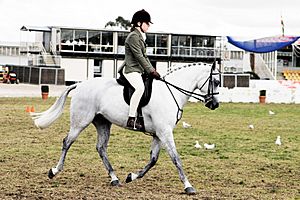
Ponies are taxonomically the same animals as horses. The distinction between a horse and pony is commonly drawn on the basis of height, especially for competition purposes. However, height alone is not dispositive; the difference between horses and ponies may also include aspects of phenotype, including conformation and temperament.
The traditional standard for height of a horse or a pony at maturity is 14.2 hands (58 inches, 147 cm). An animal 14.2 h or over is usually considered to be a horse and one less than 14.2 h a pony, but there are many exceptions to the traditional standard. In Australia, ponies are considered to be those under 14 hands (56 inches, 142 cm). For competition in the Western division of the United States Equestrian Federation, the cutoff is 14.1 hands (57 inches, 145 cm). The International Federation for Equestrian Sports, the world governing body for horse sport, uses metric measurements and defines a pony as being any horse measuring less than 148 centimetres (58.27 in) at the withers without shoes, which is just over 14.2 h, and 149 centimetres (58.66 in), or just over 14.2½ h, with shoes.
Height is not the sole criterion for distinguishing horses from ponies. Breed registries for horses that typically produce individuals both under and over 14.2 h consider all animals of that breed to be horses regardless of their height. Conversely, some pony breeds may have features in common with horses, and individual animals may occasionally mature at over 14.2 h, but are still considered to be ponies.
Ponies often exhibit thicker manes, tails, and overall coat. They also have proportionally shorter legs, wider barrels, heavier bone, shorter and thicker necks, and short heads with broad foreheads. They may have calmer temperaments than horses and also a high level of intelligence that may or may not be used to cooperate with human handlers. Small size, by itself, is not an exclusive determinant. For example, the Shetland pony which averages 10 hands (40 inches, 102 cm), is considered a pony. Conversely, breeds such as the Falabella and other miniature horses, which can be no taller than 30 inches (76 cm), are classified by their registries as very small horses, not ponies.
Genetics
Horses have 64 chromosomes. The horse genome was sequenced in 2007. It contains 2.7 billion DNA base pairs, which is larger than the dog genome, but smaller than the human genome or the bovine genome. The map is available to researchers.
Colors and markings
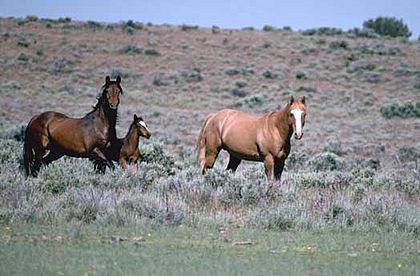
Horses exhibit a diverse array of coat colors and distinctive markings, described by a specialized vocabulary. Often, a horse is classified first by its coat color, before breed or sex. Horses of the same color may be distinguished from one another by white markings, which, along with various spotting patterns, are inherited separately from coat color.
Many genes that create horse coat colors and patterns have been identified. Current genetic tests can identify at least 13 different alleles influencing coat color, and research continues to discover new genes linked to specific traits. The basic coat colors of chestnut and black are determined by the gene controlled by the Melanocortin 1 receptor, also known as the "extension gene" or "red factor," as its recessive form is "red" (chestnut) and its dominant form is black. Additional genes control suppression of black color to point coloration that results in a bay, spotting patterns such as pinto or leopard, dilution genes such as palomino or dun, as well as graying, and all the other factors that create the many possible coat colors found in horses.
Horses that have a white coat color are often mislabeled; a horse that looks "white" is usually a middle-aged or older gray. Grays are born a darker shade, get lighter as they age, but usually keep black skin underneath their white hair coat (with the exception of pink skin under white markings). The only horses properly called white are born with a predominantly white hair coat and pink skin, a fairly rare occurrence. Different and unrelated genetic factors can produce white coat colors in horses, including several different alleles of dominant white and the sabino-1 gene. However, there are no "albino" horses, defined as having both pink skin and red eyes.
Reproduction and development
Gestation lasts approximately 340 days, with an average range 320–370 days, and usually results in one foal; twins are rare. Horses are a precocial species, and foals are capable of standing and running within a short time following birth. Foals are usually born in the spring. The estrous cycle of a mare occurs roughly every 19–22 days and occurs from early spring into autumn. Most mares enter an anestrus period during the winter and thus do not cycle in this period. Foals are generally weaned from their mothers between four and six months of age.
Horses, particularly colts, sometimes are physically capable of reproduction at about 18 months, but domesticated horses are rarely allowed to breed before the age of three, especially females. Horses four years old are considered mature, although the skeleton normally continues to develop until the age of six; maturation also depends on the horse's size, breed, sex, and quality of care. Larger horses have larger bones; therefore, not only do the bones take longer to form bone tissue, but the epiphyseal plates are larger and take longer to convert from cartilage to bone. These plates convert after the other parts of the bones, and are crucial to development.
Depending on maturity, breed, and work expected, horses are usually put under saddle and trained to be ridden between the ages of two and four. Although Thoroughbred race horses are put on the track as young as the age of two in some countries, horses specifically bred for sports such as dressage are generally not put under saddle until they are three or four years old, because their bones and muscles are not solidly developed. For endurance riding competition, horses are not deemed mature enough to compete until they are a full 60 calendar months (five years) old.
Anatomy
Skeletal system
The horse skeleton averages 205 bones. A significant difference between the horse skeleton and that of a human is the lack of a collarbone—the horse's forelimbs are attached to the spinal column by a powerful set of muscles, tendons, and ligaments that attach the shoulder blade to the torso. The horse's legs and hooves are also unique structures. Their leg bones are proportioned differently from those of a human. For example, the body part that is called a horse's "knee" is actually made up of the carpal bones that correspond to the human wrist. Similarly, the hock contains bones equivalent to those in the human ankle and heel. The lower leg bones of a horse correspond to the bones of the human hand or foot, and the fetlock (incorrectly called the "ankle") is actually the proximal sesamoid bones between the cannon bones (a single equivalent to the human metacarpal or metatarsal bones) and the proximal phalanges, located where one finds the "knuckles" of a human. A horse also has no muscles in its legs below the knees and hocks, only skin, hair, bone, tendons, ligaments, cartilage, and the assorted specialized tissues that make up the hoof.
Hooves
The critical importance of the feet and legs is summed up by the traditional adage, "no foot, no horse". The horse hoof begins with the distal phalanges, the equivalent of the human fingertip or tip of the toe, surrounded by cartilage and other specialized, blood-rich soft tissues such as the laminae. The exterior hoof wall and horn of the sole is made of keratin, the same material as a human fingernail. The end result is that a horse, weighing on average 500 kilograms (1,100 lb), travels on the same bones as would a human on tiptoe. For the protection of the hoof under certain conditions, some horses have horseshoes placed on their feet by a professional farrier. The hoof continually grows, and in most domesticated horses needs to be trimmed (and horseshoes reset, if used) every five to eight weeks, though the hooves of horses in the wild wear down and regrow at a rate suitable for their terrain.
Teeth
Horses are adapted to grazing. In an adult horse, there are 12 incisors at the front of the mouth, adapted to biting off the grass or other vegetation. There are 24 teeth adapted for chewing, the premolars and molars, at the back of the mouth. Stallions and geldings have four additional teeth just behind the incisors, a type of canine teeth called "tushes". Some horses, both male and female, will also develop one to four very small vestigial teeth in front of the molars, known as "wolf" teeth, which are generally removed because they can interfere with the bit. There is an empty interdental space between the incisors and the molars where the bit rests directly on the gums, or "bars" of the horse's mouth when the horse is bridled.
An estimate of a horse's age can be made from looking at its teeth. The teeth continue to erupt throughout life and are worn down by grazing. Therefore, the incisors show changes as the horse ages; they develop a distinct wear pattern, changes in tooth shape, and changes in the angle at which the chewing surfaces meet. This allows a very rough estimate of a horse's age, although diet and veterinary care can also affect the rate of tooth wear.
Digestion
Horses are herbivores with a digestive system adapted to a forage diet of grasses and other plant material, consumed steadily throughout the day. Therefore, compared to humans, they have a relatively small stomach but very long intestines to facilitate a steady flow of nutrients. A 450-kilogram (990 lb) horse will eat 7 to 11 kilograms (15 to 24 lb) of food per day and, under normal use, drink 38 to 45 litres (8.4 to 9.9 imp gal; 10 to 12 US gal) of water. Horses are not ruminants, they have only one stomach, like humans, but unlike humans, they can utilize cellulose, a major component of grass. Horses are hindgut fermenters. Cellulose fermentation by symbiotic bacteria occurs in the cecum, or "water gut", which food goes through before reaching the large intestine. Horses cannot vomit, so digestion problems can quickly cause colic, a leading cause of death.
Senses
The horses' senses are based on their status as prey animals, where they must be aware of their surroundings at all times. They have the largest eyes of any land mammal, and are lateral-eyed, meaning that their eyes are positioned on the sides of their heads. This means that horses have a range of vision of more than 350°, with approximately 65° of this being binocular vision and the remaining 285° monocular vision. Horses have excellent day and night vision, but they have two-color, or dichromatic vision; their color vision is somewhat like red-green color blindness in humans, where certain colors, especially red and related colors, appear as a shade of green.
Their sense of smell, while much better than that of humans, is not quite as good as that of a dog. It is believed to play a key role in the social interactions of horses as well as detecting other key scents in the environment. Horses have two olfactory centers. The first system is in the nostrils and nasal cavity, which analyze a wide range of odors. The second, located under the nasal cavity, are the Vomeronasal organs, also called Jacobson's organs. These have a separate nerve pathway to the brain and appear to primarily analyze pheromones.
A horse's hearing is good, and the pinna of each ear can rotate up to 180°, giving the potential for 360° hearing without having to move the head. Noise impacts the behavior of horses and certain kinds of noise may contribute to stress: A 2013 study in the UK indicated that stabled horses were calmest in a quiet setting, or if listening to country or classical music, but displayed signs of nervousness when listening to jazz or rock music. This study also recommended keeping music under a volume of 21 decibels. An Australian study found that stabled racehorses listening to talk radio had a higher rate of gastric ulcers than horses listening to music, and racehorses stabled where a radio was played had a higher overall rate of ulceration than horses stabled where there was no radio playing.
Horses have a great sense of balance, due partly to their ability to feel their footing and partly to highly developed proprioception—the unconscious sense of where the body and limbs are at all times. A horse's sense of touch is well developed. The most sensitive areas are around the eyes, ears, and nose. Horses are able to sense contact as subtle as an insect landing anywhere on the body.
Horses have an advanced sense of taste, which allows them to sort through fodder and choose what they would most like to eat, and their prehensile lips can easily sort even small grains. Horses generally will not eat poisonous plants, however, there are exceptions; horses will occasionally eat toxic amounts of poisonous plants even when there is adequate healthy food.
Movement
All horses move naturally with four basic gaits: the four-beat walk, which averages 6.4 kilometres per hour (4.0 mph); the two-beat trot or jog at 13 to 19 kilometres per hour (8.1 to 11.8 mph) (faster for harness racing horses); the canter or lope, a three-beat gait that is 19 to 24 kilometres per hour (12 to 15 mph); and the gallop. The gallop averages 40 to 48 kilometres per hour (25 to 30 mph), but the world record for a horse galloping over a short, sprint distance is 70.76 kilometres per hour (43.97 mph). Besides these basic gaits, some horses perform a two-beat pace, instead of the trot. There also are several four-beat "ambling" gaits that are approximately the speed of a trot or pace, though smoother to ride. These include the lateral rack, running walk, and tölt as well as the diagonal fox trot. Ambling gaits are often genetic in some breeds, known collectively as gaited horses. Often, gaited horses replace the trot with one of the ambling gaits.
Behavior
Horses are prey animals with a strong fight-or-flight response. Their first reaction to threat is to startle and usually flee, although they will stand their ground and defend themselves when flight is impossible or if their young are threatened. They also tend to be curious; when startled, they will often hesitate an instant to ascertain the cause of their fright, and may not always flee from something that they perceive as non-threatening. Most light horse riding breeds were developed for speed, agility, alertness and endurance; natural qualities that extend from their wild ancestors. However, through selective breeding, some breeds of horses are quite docile, particularly certain draft horses.
Horses are herd animals, with a clear hierarchy of rank, led by a dominant individual, usually a mare. They are also social creatures that are able to form companionship attachments to their own species and to other animals, including humans. They communicate in various ways, including vocalizations such as nickering or whinnying, mutual grooming, and body language. Many horses will become difficult to manage if they are isolated, but with training, horses can learn to accept a human as a companion, and thus be comfortable away from other horses. However, when confined with insufficient companionship, exercise, or stimulation, individuals may develop stable vices, an assortment of bad habits, mostly stereotypies of psychological origin, that include wood chewing, wall kicking, "weaving" (rocking back and forth), and other problems.
Intelligence and learning
Studies have indicated that horses perform a number of cognitive tasks on a daily basis, meeting mental challenges that include food procurement and identification of individuals within a social system. They also have good spatial discrimination abilities. They are naturally curious and apt to investigate things they have not seen before. Studies have assessed equine intelligence in areas such as problem solving, speed of learning, and memory. Horses excel at simple learning, but also are able to use more advanced cognitive abilities that involve categorization and concept learning. They can learn using habituation, desensitization, classical conditioning, and operant conditioning, and positive and negative reinforcement. One study has indicated that horses can differentiate between "more or less" if the quantity involved is less than four.
Domesticated horses may face greater mental challenges than wild horses, because they live in artificial environments that prevent instinctive behavior whilst also learning tasks that are not natural. Horses are animals of habit that respond well to regimentation, and respond best when the same routines and techniques are used consistently. One trainer believes that "intelligent" horses are reflections of intelligent trainers who effectively use response conditioning techniques and positive reinforcement to train in the style that best fits with an individual animal's natural inclinations.
Sport
Historically, equestrians honed their skills through games and races. Equestrian sports provided entertainment for crowds and honed the excellent horsemanship that was needed in battle. Many sports, such as dressage, eventing and show jumping, have origins in military training, which were focused on control and balance of both horse and rider. Other sports, such as rodeo, developed from practical skills such as those needed on working ranches and stations. Sport hunting from horseback evolved from earlier practical hunting techniques. Horse racing of all types evolved from impromptu competitions between riders or drivers. All forms of competition, requiring demanding and specialized skills from both horse and rider, resulted in the systematic development of specialized breeds and equipment for each sport. The popularity of equestrian sports through the centuries has resulted in the preservation of skills that would otherwise have disappeared after horses stopped being used in combat.
Horses are trained to be ridden or driven in a variety of sporting competitions. Examples include show jumping, dressage, three-day eventing, competitive driving, endurance riding, gymkhana, rodeos, and fox hunting. Horse shows, which have their origins in medieval European fairs, are held around the world. They host a huge range of classes, covering all of the mounted and harness disciplines, as well as "In-hand" classes where the horses are led, rather than ridden, to be evaluated on their conformation. The method of judging varies with the discipline, but winning usually depends on style and ability of both horse and rider. Sports such as polo do not judge the horse itself, but rather use the horse as a partner for human competitors as a necessary part of the game. Although the horse requires specialized training to participate, the details of its performance are not judged, only the result of the rider's actions—be it getting a ball through a goal or some other task. Examples of these sports of partnership between human and horse include jousting, in which the main goal is for one rider to unseat the other, and buzkashi, a team game played throughout Central Asia, the aim being to capture a goat carcass while on horseback.
Horse racing is an equestrian sport and major international industry, watched in almost every nation of the world. There are three types: "flat" racing; steeplechasing, i.e. racing over jumps; and harness racing, where horses trot or pace while pulling a driver in a small, light cart known as a sulky. A major part of horse racing's economic importance lies in the gambling associated with it.
Work
There are certain jobs that horses do very well, and no technology has yet developed to fully replace them. For example, mounted police horses are still effective for certain types of patrol duties and crowd control. Cattle ranches still require riders on horseback to round up cattle that are scattered across remote, rugged terrain. Search and rescue organizations in some countries depend upon mounted teams to locate people, particularly hikers and children, and to provide disaster relief assistance. Horses can also be used in areas where it is necessary to avoid vehicular disruption to delicate soil, such as nature reserves. They may also be the only form of transport allowed in wilderness areas. Horses are quieter than motorized vehicles. Law enforcement officers such as park rangers or game wardens may use horses for patrols, and horses or mules may also be used for clearing trails or other work in areas of rough terrain where vehicles are less effective.
Although machinery has replaced horses in many parts of the world, an estimated 100 million horses, donkeys and mules are still used for agriculture and transportation in less developed areas. This number includes around 27 million working animals in Africa alone. Some land management practices such as cultivating and logging can be efficiently performed with horses. In agriculture, less fossil fuel is used and increased environmental conservation occurs over time with the use of draft animals such as horses. Logging with horses can result in reduced damage to soil structure and less damage to trees due to more selective logging.
Entertainment and culture
Modern horses are often used to reenact many of their historical work purposes. Horses are used, complete with equipment that is authentic or a meticulously recreated replica, in various live action historical reenactments of specific periods of history, especially recreations of famous battles. Horses are also used to preserve cultural traditions and for ceremonial purposes. Countries such as the United Kingdom still use horse-drawn carriages to convey royalty and other VIPs to and from certain culturally significant events. Public exhibitions are another example, such as the Budweiser Clydesdales, seen in parades and other public settings, a team of draft horses that pull a beer wagon similar to that used before the invention of the modern motorized truck.
Horses are frequently seen in television, films and literature. They are sometimes featured as a major character in films about particular animals, but also used as visual elements that assure the accuracy of historical stories. Both live horses and iconic images of horses are used in advertising to promote a variety of products. The horse frequently appears in coats of arms in heraldry, in a variety of poses and equipment. The mythologies of many cultures, including Greco-Roman, Hindu, Islamic, and Norse, include references to both normal horses and those with wings or additional limbs, and multiple myths also call upon the horse to draw the chariots of the Moon and Sun. The horse also appears in the 12-year cycle of animals in the Chinese zodiac related to the Chinese calendar.
Warfare
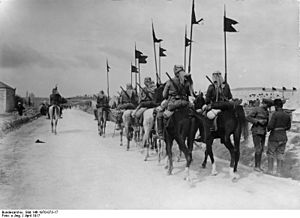
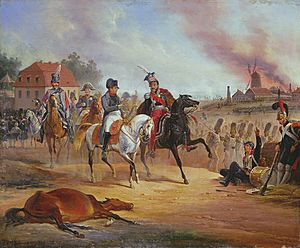
Horses have been used in warfare for most of recorded history. The first archaeological evidence of horses used in warfare dates to between 4000 and 3000 BC, and the use of horses in warfare was widespread by the end of the Bronze Age. Although mechanization has largely replaced the horse as a weapon of war, horses are still seen today in limited military uses, mostly for ceremonial purposes, or for reconnaissance and transport activities in areas of rough terrain where motorized vehicles are ineffective.
Other uses of horses
Horsehide is a tough leather made from the skin of horses. Horsehair is used to make a stiff fabric. Horsehair can also be used as a stuffing for furniture. Horsehair can be mixed with plaster to make it strong.
Horse bones can be used to make gelatin for food. The bones can also be used to make glue. Animal glue is still preferred by some wood workers.
Horses are used all over the world to carry people and pull carts.
They are used by police in big cities. Police horses help police watch and protect people in crowds.
Horse Breeds
These are some examples of horse breeds:
- Arabian horse
- Exmoor pony
- Friesian
- Lipizzaner
- Thoroughbred
Related pages
- Horse riding – sports with horses
- Pony – for little horses
- Quagga
- Przewalski's Horse
- Donkey (Ass)
- Mule
- Zebra
Images for kids
See also
 In Spanish: Equus ferus caballus para niños
In Spanish: Equus ferus caballus para niños


